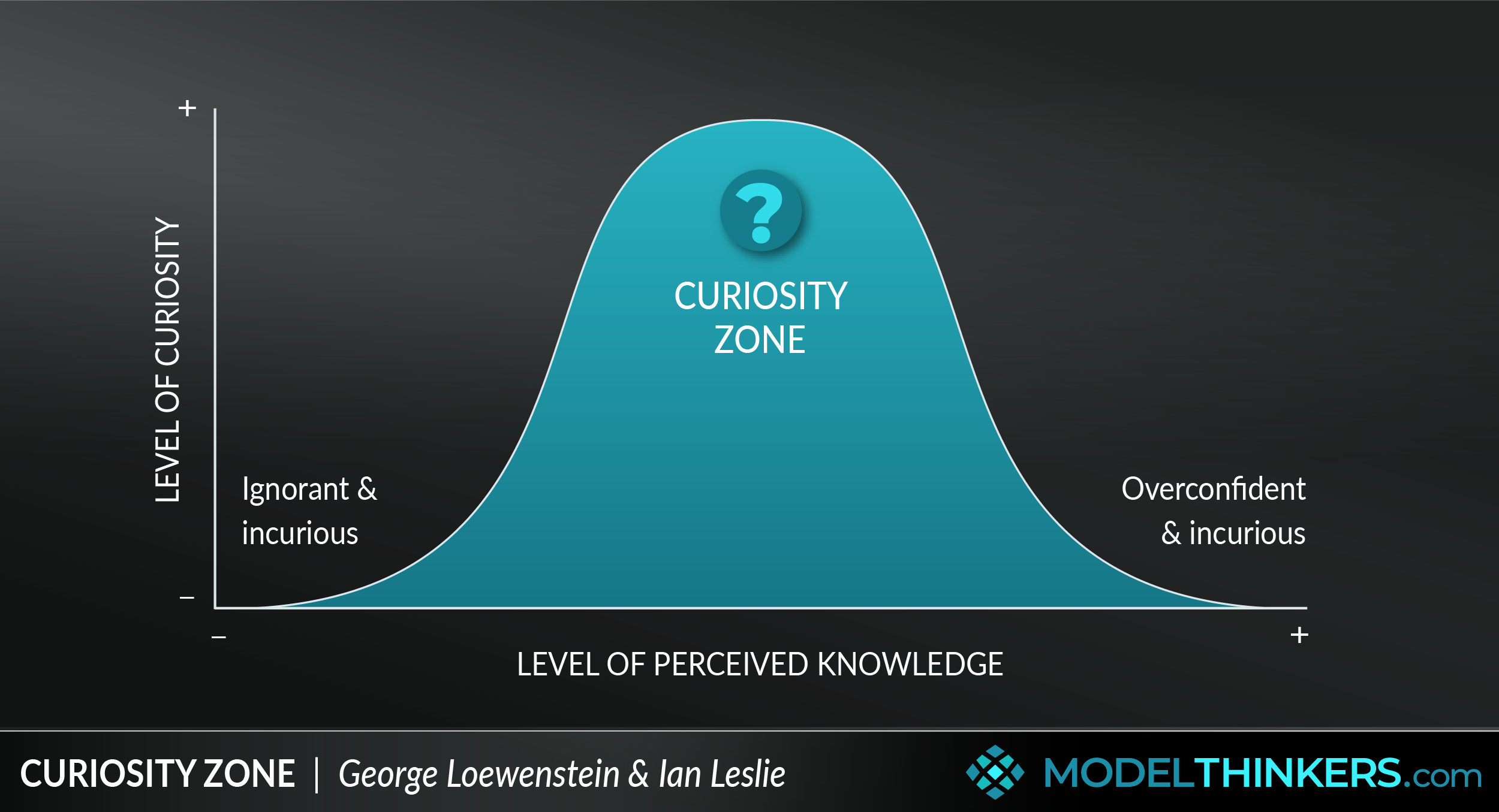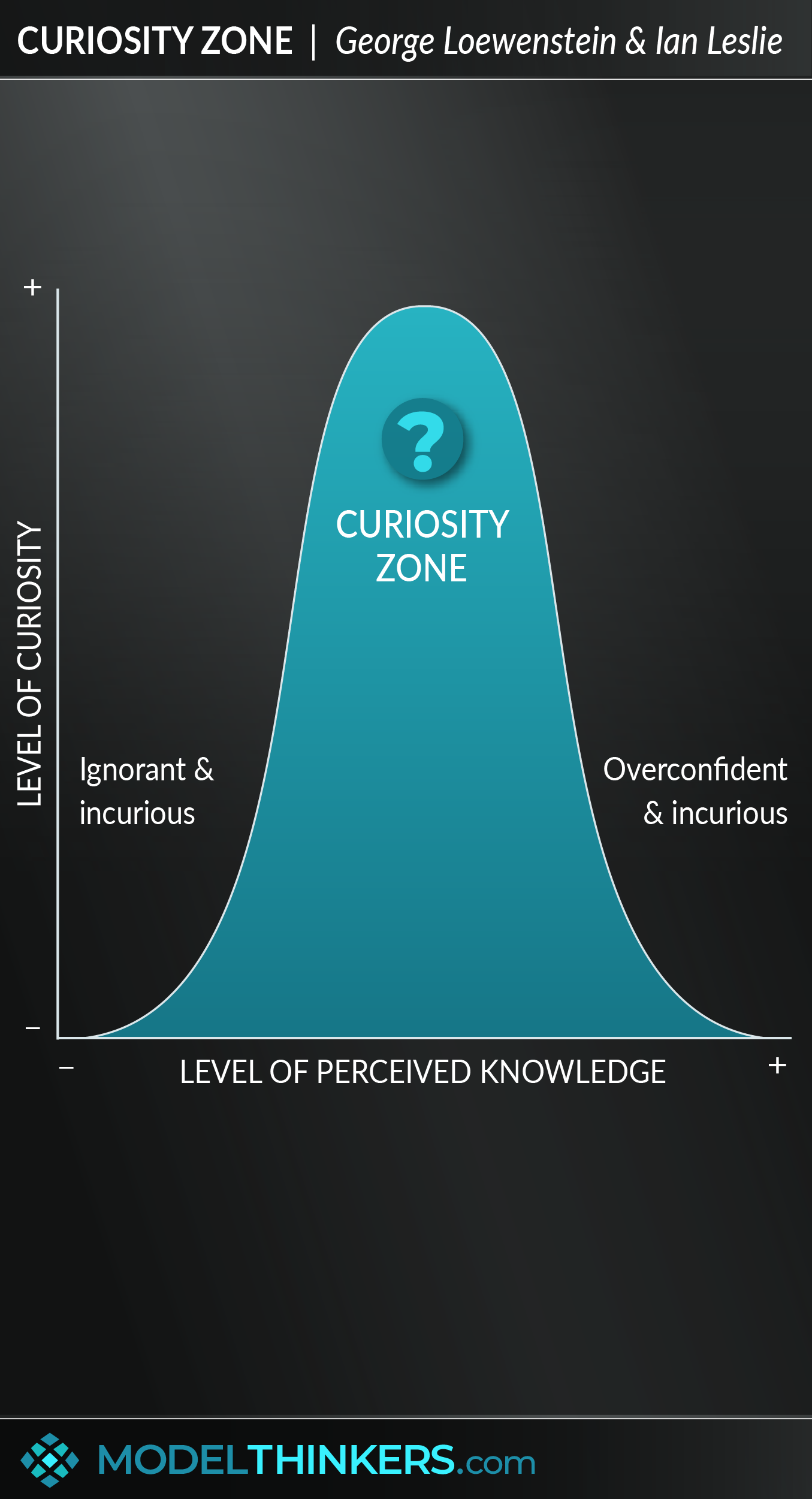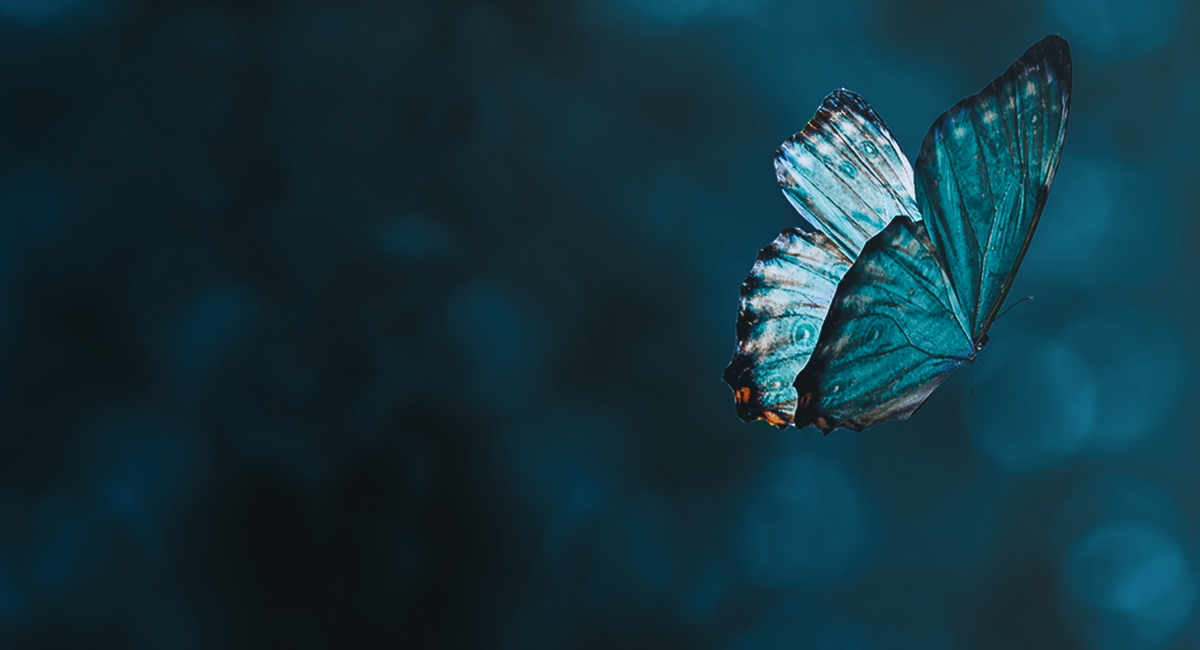

 0 saved
0 saved
 31.8K views
31.8K views








There are few that would deny the power of curiosity. Just consider how:
-
being curious about yourself will help drive self-awareness and growth;
-
being curious about others will help drive empathy and collaboration;
-
being curious about ideas will help drive learning and understanding;
-
and being curious about challenges will help drive problem-solving and innovation.
Given all of that, you'll want to explore this model that helps you better understand and tap into the power of curiosity.
The Curiosity Zone describes your tendency to be the most curious when you know something about a subject. And the most incurious when you are completely ignorant about it or view yourself as an expert in it.
BEWARE IGNORANCE - CURIOSITY NEEDS PURCHASE.
The Curiosity Zone is inspired by George Loewenstein’s 1994 Information-Gap Theory, although it was effectively distilled in Ian Leslie’s highly recommended book Curious — thus I’ve co-attributed this model, even though the two did not work together directly, see the Origins section below for more.
Loewenstein’s Information-Gap Theory argues that initial information acts as a 'priming dose' or purchase for increased curiosity. Loewenstein explained: “There are many things that people don’t know and that don’t bother them, but awareness of specific pieces of missing information can prompt an unreasonably strong desire to fill these gaps.”
The takeaway here is that initial knowledge in an area builds your potential of developing information gaps, which in turn drives curiosity for more knowledge to bridge that gap.
EXPERTS BEWARE - OVERCONFIDENCE KILLS CURIOSITY.
“By the time we are adults we have fewer questions, and more default settings.” — Jean Piaget
When he became CEO of Microsoft, Satya Nadella discovered that Piaget’s observation applied doubly to the gap between novices and experts. Nadella famously inherited a toxic culture where countless experts had fixed ideas, methods of practice could not be challenged, and innovation was limited as a result.
One of Nadella's first actions as CEO was to highlight the lack of learning and curiosity at Microsoft, arguing that “the learn-it-all does better than the know-it-all”, as part of a broader campaign to embrace a Growth Mindset and culture of curiosity.
Rather than being an indictment of expertise, the Curiosity Zone exposes the inverse relationship between high levels of perceived expertise and curiosity, so can act as an important cautionary tale against complacency. It warns against 'settling' into your existing ideas, no matter how well-formed they are, especially when you live in a complex, fast-changing, and unpredictable world. The challenge then is for experts to remain open and curious about the mysteries of their familiar domain — no easy task!
USE IT ON YOURSELF AND TO ENGAGE WITH OTHERS.
Your first instinct will likely to be to apply this model on yourself, supporting yourself to develop curiosity even when you're new to a topic or are an expert on it. And that's great! As I said up front, there are countless benefits to doing that.
But don't leave it there. Consider how you can use this model to boost the way you communicate, persuade and present. Ask yourself, how can I give my audience enough information to develop the curious tension that comes with an information-gap?
LESLIE’S CURIOSITY TIPS.
In Curious, Leslie outlines several strategies to boost your curiosity:
-
Stay foolish - have the courage to ask the ‘stupid’ questions and be honest about your information gaps.
-
Build the database - understanding the Curiosity Zone, Leslie argues for the power of building knowledge as a purchase to grow further knowledge.
-
Forage like a 'foxhog' - similar to the T-Shaped People , Leslie advocates for the combination of deep knowledge with a cross-disciplinary breadth.
-
Ask the big why - considering the big questions and challenging accepted assumptions.
-
Be a 'thinkerer' - combining thinker and tinker, this term combines the micro and macro, or the practical and theoretical in playful cycles of experiment and thought.
-
Question your teaspoons - looking at the ordinary and every day but challenging the way that you view and use them. This has much resonance with challenging Functional Fixedness.
-
Turn puzzles into mysteries - Leslie points out that puzzles have a defined answer and can be solved, while mysteries are open-ended and are more enduring as a result. He points to our cultural obsession with puzzles — on getting an answer, particularly in our internet age. However, he advocates for the power of embracing and exploring mysteries.
This quick summary doesn’t do justice to Leslie's calls to action but, hopefully, it’s enough information to provide an information-gap in your mind that drives your curiosity to buy his book.
IN YOUR LATTICEWORK.
The Curiosity Zone is a conceptual cousin to the Zeigarnik Effect, particularly in terms of creating a tension between an unfinished task or, in this case, a body of incomplete knowledge.
It's important to note that the Curiosity Zone is not the only consideration when understanding levels of Curiosity (see Limitations for more). For example, you might also explore Psychological Safety when aiming to shift a team or organisation's culture of curiosity.
We’ve already cited T-Shaped People in reference to Leslie’s ‘foxhog’ tip. In addition, I’d argue that his call to ‘build a database’ will be boosted by focusing on building a Latticework of Mental Models to actively scaffold and build understanding rather than just accumulate factual information. And ‘asking the big why’ will be assisted by models such as the 5 Whys.
Activation Energy can help you understand the difficulty of starting to accumulate knowledge in a new and unexplored area. On the other side of the spectrum, when considering experts, you might better maintain humility with models like Map vs Territory.
Continuing the expert theme, consider leveraging models such as First Principles, Framestorming, and/or Idea Sex to challenge your existing expert assumptions and rekindle your curiosity in an area that you might have developed some complacency in.
Finally, use curiosity to better challenge the Confirmation Heuristic, by exploring your existing beliefs and mental models.




-
Identify your areas of ‘know-it-all’ and ignorance.
What area do you believe you really 'get'? And what do you have no clue about? They are the areas that are likely going to be your incurious zones, so shine a light on them. Such self-awareness will enable you to implement strategies on either side of the Curiosity Zone to foster greater curiosity.
-
Learn something totally new, regularly.
Develop a habit of learning something completely new, of diving into an unfamiliar area where you have no context. Doing so will help broaden your foundational knowledge and provide more potential information-gap moments that can drive more learning.
-
Embrace T-Shaped People skills and build a diverse Latticework of Mental Models.
Building on the previous point, consider how to develop both depth and breadth of knowledge. And, in terms of breadth, consider exploring the ‘big ideas from the big disciplines’ as a broad framework to drive future curiosity.
-
Work in diverse cross-functional teams
Diverse and cross-functional teams, where each of you has wildly different Curiosity Zones on any topic, will help to ensure that someone in the room is driving curious investigation at all times. This might be an ongoing team, or actively seeking feedback from people who lay at different parts of the Curiosity Zone spectrum, including novices.
-
Ask more questions and release your playful mind.
We know it’s tempting to solve, to fix, to ‘complete the puzzle.’ But suspend that and instead try to imagine that you’re exploring an open-ended mystery. Be playful, ask ‘what if?’ and ‘why?’ questions and investigate.
-
Schedule curious moments.
Curiosity is something that needs to be actively built. You need to exercise it and develop it consciously, so why wouldn’t you schedule it? Use models such as First Principles, Framestorming and/or Idea Sex to help you in those moments.
-
Explore through experimentation.
Taking that ‘thinkerer’ call to action from Ian Leslie, consider how you can use curiosity to drive rapid cycles of thinking and action to accelerate your learning. Inspired by the Scientific Method, this might include how you apply Double Loop Learning, or even at a team level how you implement Agile Methodology. The point, without curiosity and openness, such processes can be implemented in linear and fixed ways — maintain your Curiosity Zone to ensure they are truly explorative and reactive to feedback.
This model is just one frame for curiosity which is obviously complex and multifaceted.
In his book Curious, Leslie discusses other factors such as safety and confidence that drive (or severely limits) curiosity. Leslie also explores different types of curiosity, pointing out that diversive curiosity is more about seeking novelty and surprise, and can be relatively impetuous.
By contrast, epistemic curiosity is the type of curiosity that is described by this model, as it relates to consciously seeking knowledge and exploring a question.
Stories.
In his book Curious, Leslie discusses his experience with screenwriting teacher Robert McKee. McKee explained, “curiosity is the intellectual need to answer questions and close open patterns. Story plays to this universal desire by doing the opposite, posing questions and opening situations.”
He explained that addictive stories must offer continual turning points where the audience wonders ‘What will happen next?’ and ‘How will it turn out?’
Trivia experiment.
The U-shaped approach inherent to this model was validated in a 2004 experiment by Jeong Kang et al where they scanned subjects with functional magnetic resonance imaging while they read trivia questions. Quoting this paper now, “[Kang et al] found that curiosity about the answer to a trivia question is a U-shaped function of confidence about knowing that answer. Decision-makers were least curious when they had no clue about the answer and when they were extremely confident. They were most curious when they had some idea about the answer but lacked confidence.”
d
This model is based on George Loewenstein’s 1994 Information-Gap Theory which you can read about in the original academic paper here. However, the actual Curious Zone model was distilled and best explained in Ian Leslie’s book Curious. Leslie has given many interviews about curiosity and related topics, find out more about them, and his broader body of work at his website.
In the book, Leslie introduces three U-shaped graphs to represent curiosity, mapped against ‘surprise’, ‘knowledge’, and ‘confidence’. We’ve gone with a single graph of ‘perceived knowledge’, because, at the expert level, in particular, the self-perception of your understanding and completeness of the domain is a bigger hindrance than your actual knowledge.
Loewenstein’s Information-Gap theory related to curiosity should not be mistaken with Info-Gap theory which is a decision-making theory used in uncertain domains.
 My Notes
My Notes
Oops, That’s Members’ Only!
Fortunately, it only costs US$5/month to Join ModelThinkers and access everything so that you can rapidly discover, learn, and apply the world’s most powerful ideas.
ModelThinkers membership at a glance:






“Yeah, we hate pop ups too. But we wanted to let you know that, with ModelThinkers, we’re making it easier for you to adapt, innovate and create value. We hope you’ll join us and the growing community of ModelThinkers today.”























































































